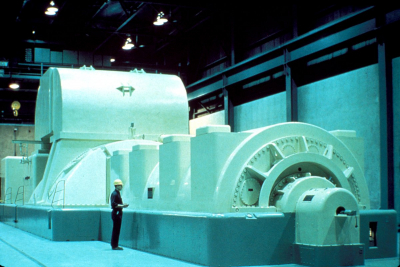Hoover Dam is a concrete arch-gravity dam in the Black Canyon of the Colorado River, on the border between the U.S. states of Nevada and Arizona. It was constructed between 1931 and 1936 during the Great Depression and was dedicated on September 30, 1935, by President Franklin D. Roosevelt. Its construction was the result of a massive effort involving thousands of workers, and cost over one hundred lives. It was referred to as Hoover Dam after President Herbert Hoover in bills passed by Congress during its construction; it was named Boulder Dam by the Roosevelt administration. The Hoover Dam name was restored by Congress in 1947.
Since about 1900, the Black Canyon and nearby Boulder Canyon had been investigated for their potential to support a dam that would control floods, provide irrigation water and produce hydroelectric power. In 1928, Congress authorized the project. The winning bid to build the dam was submitted by a consortium named Six Companies, Inc., which began construction of the dam in early 1931. Such a large concrete structure had never been built before, and some of the techniques were unproven. The torrid summer weather and lack of facilities near the site also presented difficulties. Nevertheless, Six Companies turned the dam over to the federal government on March 1, 1936, more than two years ahead of schedule.
Hoover Dam impounds Lake Mead, the largest reservoir in the United States by volume when full. The dam is located near Boulder City, Nevada, a municipality originally constructed for workers on the construction project, about 30 mi (48 km) southeast of Las Vegas, Nevada. The dam's generators provide power for public and private utilities in Nevada, Arizona, and California. Hoover Dam is a major tourist attraction, with 7 million tourists a year. The heavily traveled U.S. Route 93 (US 93) ran along the dam's crest until October 2010, when the Hoover Dam Bypass opened.
In electricity generation, a generator is a device that converts motive power (mechanical energy) into electric power for use in an external circuit. Sources of mechanical energy include steam turbines, gas turbines, water turbines, internal combustion engines, wind turbines and even hand cranks. The first electromagnetic generator, the Faraday disk, was invented in 1831 by British scientist Michael Faraday. Generators provide nearly all of the power for electric power grids.
The reverse conversion of electrical energy into mechanical energy is done by an electric motor, and motors and generators have many similarities. Many motors can be mechanically driven to generate electricity; frequently they make acceptable manual generators.

1936Oct, 26
The first electric generator at Hoover Dam goes into full operation.
Choose Another Date
Events on 1936
- 7Mar
Treaty of Versailles
Prelude to World War II: In violation of the Locarno Pact and the Treaty of Versailles, Germany reoccupies the Rhineland. - 29Mar
Remilitarization of the Rhineland
In Germany, Adolf Hitler receives 99% of the votes in a referendum to ratify Germany's illegal remilitarization and reoccupation of the Rhineland, receiving 44.5 million votes out of 45.5 million registered voters. - 9May
Addis Ababa
Italy formally annexes Ethiopia after taking the capital Addis Ababa on May 5. - 26Jul
Spanish Civil War
The Axis powers decide to intervene in the Spanish Civil War. - 7Sep
Benjamin the thylacine
The last thylacine, a carnivorous marsupial named Benjamin, dies alone in its cage at the Hobart Zoo in Tasmania.

 English
English  español
español  français
français  português
português  русский
русский  العربية
العربية  简体中文
简体中文 